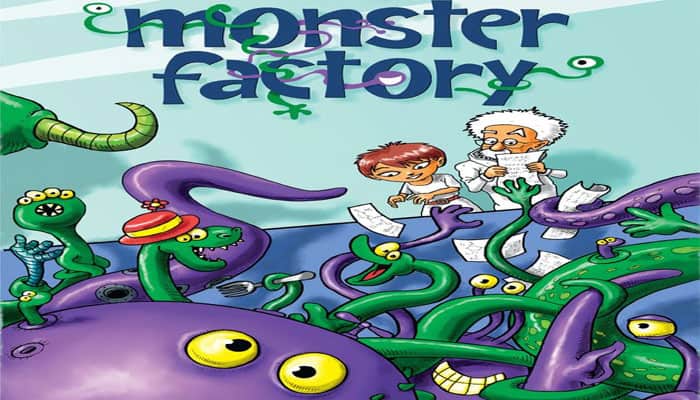
The players take turns drawing and placing tiles, either adding to their own monsters or to those of their opponents. The goal is to make a big monster, but not so big that it goes unfinished!

Components
- 88 monster tiles
- rule booklet
Setup
Each player picks a tile to start with. Tiles that connect on 3 or 4 sides are good choices. Each player places his tile in front of him on the table; that is a player's "monster-in-progress".
Shuffle the rest of the tiles face down into a big mound or in separate piles.

Game Play
The players choose a starting player and take turns in clockwise order. On a player's turn, he draws one facedown tile and adds it to anyone's monster - his own or another player's.
If there is a monster the player can add it to, he must do so. The player may not choose to discard a playable tile.
If it does not fit anywhere and all other players agree, the player discards the tile back into the box (it will not be played in this game) and draws a replacement.
Once a player has played a tile, his turn ends and the next player takes his turn.
Each edge of a tile shows either a thin bit of monster (colored green), a thick bit of monster (colored purple), or blank (white).

Players must place each tile such that a thin edge or thick edge matches the same thickness on the edge of a tile on someone's monster.
Also no touching edges can mismatch - a player cannot place a tile with thin next to thick, thin next to blank, or thick next to blank.
A player can place a tile with blank next to blank, but the tile must connect to another tile on at least one thin or thick side. New tile has red border in the examples.


If a player's monster has no thin or thick edges to connect to, the monster is complete. The player immediately draws a random tile to start a new monster, which is called a minion.
He does this even if it is not his turn - and if his turn is next, this does not count as his turn. When a player completes a minion, he starts another. A player may never have more than one monster or minion "in progress" at any time.
When a player has completed his first monster, the player can no longer place tiles on other players' first monsters. Such a player can play on other players' minions, however.
If a player's monster grows too close to another player's monster, or to the edge of the table, the players may carefully move it to make more room. Players should keep it connected exactly as it was.
End of the Game
When all players' first monsters are complete or no face-down tiles are left, the game is over.
Scoring
Each player scores one point per tile in a completed first monster, and one point per tile showing an eye in each completed minion (one point per tile with an eye, not one point per eye).
Uncompleted monsters and minions score no points. Remember, any exposed thin or thick bit will cause that monster to be worth 0.
Scoring examples:
Anna has one completed first monster (12 points for 12 tiles) and one incomplete minion (0 points even though it has two tiles with eyes) for a total of 12 points.

Natalie has one completed fi rst monster (9 points for 9 tiles) and two minions (0 points for no eyes in the first completed minion and 5 points for the 5 tiles with one or more eyes in the second completed minion) for a total of 14 points.

The player with the highest score wins. If there is a tie for the highest score, the tied players rejoice in their shared victory.
Continue Reading
